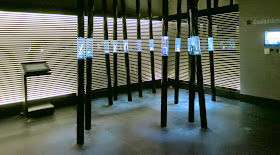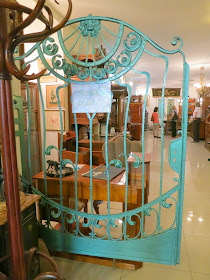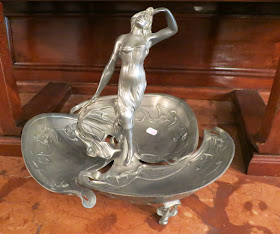The Holocaust Memorial Centre in the Ferencvaros district of Budapest.
Designed by Istvan Manyi, the memorial opened in 2004. Like Liebskind's Jewish Holocaust Museum in Berlin, the building is distorted and oppressive:
darkened ramps resounding to the crunch of jackboots and the shuffle of feet lead to artefacts, newsreels and audio-visual testimonies.
The exhibition space reflects its content: fragmentary contours, strangely balanced walls, distinctive facades - the ramps and narrow passages of the exhibition space refer to the distorted and out-of-joint world of the Holocaust.

The word 'Holocaust' originally meant a sacrificial offering to god that is entirely consumed by fire. Since the 1960s the word has come to mean the extermination of two thirds of the Jewish population of Europe between 1939 and 1945. During the years from 1939 to 1945, the Nazis and their followers persecuted and murdered millions of Poles, Russians and other nationalities in Europe besides Jews, in addition to large numbers of Gypsies, homosexuals, mental patients, Jehova's Witnesses, as well as the political and religious opponents of Nazism. The uniqueness of the Holocaust however, does not stem from the sheer number of victims; prior to 1941, never before in the history of humankind had the leaders of a state wanted to kill every single member of a people, a nationality or religious group.
This is the first room
and looking closer you can see abandoned and retrieved objects that are testimony of the Holocaust
a looted candlestick
pliers, presumably used in one of the camps
a pair of glasses, loot or maybe fallen off the face of someone who was being maltreated or worse
a child's doll
a book - all so poignant and a preparation of the horrors awaiting in the other rooms.
The exhibition is organised in a historical narrative structure showing how the Nazis and their accomplices first deprived Jews and the Roma of their
rights by declaring them secondary citizens; they set an upper limit on their number in the economic sphere - in some professions for example, the upper limit was 20% of Jews; a later act banned them from acquiring Hungarian citizenship and urged them to leave the country.
They then were deprived of their
property. This was a slow process to begin with, but within a few weeks in March 1944, the Hungarian government seized nearly all the assets of persons regarded as Jews, from wedding rings to apartment buildings and industrial plants. Torture was used to make them reveal where they had hidden their valuables.
The next assault was deprivation of their
freedom. Arrests, deportations and ghettoization: close to 150 ghettos were established within two months in 1944. On May 15, 1944 the largest and fastest deporting operation began, where the country was divided into six deportation zones. The engine of the Hungarian Holocaust was the collaboration of the civil administration and law enforcement agencies. Eichman himself had some twenty officers under him, his Kommando numbered fewer than 150 persons. Without the active, initiative-rich assistance of the Hungarian police, gendarmerie and public administration it would have been impossible to ghettoise and then deport hundreds of thousands of people within a few weeks. During the spring and summer of 1944, the entire state apparatus of wartime Hungary save the army, was actively engaged in organising the expulsion of Jews.
Being deprived of
human dignity was the next step: wearing the yellow star; the horrors of the ghettos and collecting camps; being stripped naked and tortured; routine torture; having to watch loved ones being tortured and killed; body cavity searches; rapes; having a number tattooed on the skin; race-obsessed doctors conducting experiments.
Finally, being deprived of
life. Jews and Roma were murdered indiscriminately; people were robbed, then shot and dumped in the Danube. And then, the deaths in the camps: Auschwitz-Birkenau, Dachau, Buchenwald, Bergen-Belsen, Manthaussen, Ravensbruck.
In the summer of 1944, hundreds of thousands of Hungarian Jews were deported in Auschwitz-Birkenau. Their extermination was directed by Rudolf Hoss, and the operation was named after him. The SS doctors were selecting night and day, the gas chambers were always full, the furnaces were operating continuously. The area around Birkenau was filled with heavy, suffocating smoke and the smell of burning flesh. Long flames leaped out of the chimneys of the crematoria. Sometimes, as the corpses of the previous transport were being dragged out of the gas chambers, the next group of Hungarian Jews was already waiting in the front of the crematoria, and a new train from Hungary was at the ramp.
More than 5,000 Hungarian gypsies were murdered, many of them shot in mass graves by Arrow Cross thugs and gendarmes.
Some Hungarian Jews tried to resist even at the doors of the crematoria. In the dawn of May 26, 1944, hundreds of condemned Hungarian Jews refused to enter the gas chambers and tried to break out from the closed sector of Crematorium V. Under the glare of floodlights, they were all shot.
On May 28, another Hungarian transport revolted at the same place. They wanted to run to the nearby woods, and they were all shot by the SS guards. On October 7, after months of preparations, the Jewish Sonderkommando in Birkenau rose in revolt. They blew up Crematorium IV, attacked the guards and broke out of the camp. While escaping, they cut through the barbed wire of the women's camp so that girls and women could also escape. By the end of a whole day of firing and pursuit, all the rebels had been killed.
The exhibition also pays tribute to the thousands of people who helped: during the nearly two-month-long siege of Budapest, thousands were saving their Jewish friends, acquaintances and even strangers by risking their own lives. During the reign of the Arrow Cross, rescue activity intensified despite the fact that anyone helping Jews or Gypsies was risking his/her own life.
Emerging from the bowels of hell we moved on to the restored and sunlit Art Deco Synagogue, built by Leopold Baumhorn in the 1920s.
We then ended up where we had started from, the garden/courtyard
The Tower of Lost Communities, which is also the entrance to the permanent exhibition. The Tower displays the 1441 Hungarian towns and villages that have ceased to exist as a consequence of the deportations in 1944, as inhabitants lost their lives in concentration camps or forced labour service. Its special twelve glass panes were designed by Lazslo Zsoter.
looking closer
The Wall of Victims, with thousands of names
looking closer
 Source:
Source:
From Deprivation of Rights to Genocide - the booklet that accompanies the exhibition.




































































